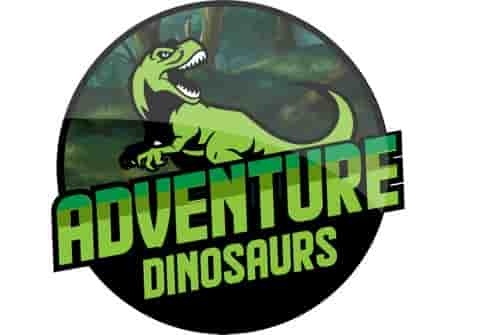The Plant-Eating Herbivorous Dinosaurs
Herbivore dinosaurs, the plant-eaters of the past, are record holders in many areas. They were the giant Sauropods, the armored dinosaurs, and some of them were Ominivores – dinosaurs that ate both vegetation and meat. It’s exciting that we have found fossils of these herbivore dinosaurs on every continent, even Antarctica. The meat-eating predators typically get the most attention; after all, they had features that were scary and impressive. But as I research more about dinosaurs and find that they so evolved many interesting characteristics, it makes me wonder what’s so cool about them?
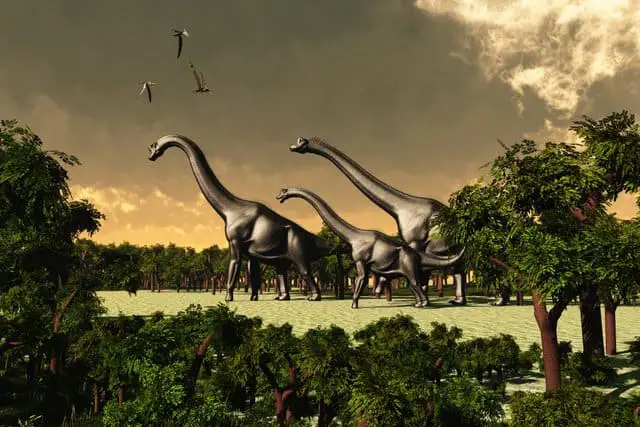
What’s So Cool About Herbivore Dinosaurs?
So, what’s so cool about herbivore dinosaurs? The plant-eating dinosaurs were so cool because they’re the biggest dinosaurs on earth, they developed armor to defend themselves to a level never seen before, and there were lots of them – about 65% of all dinosaurs. Herbivore dinosaurs include the giant Sauropods, the two-legged dinosaurs, and the armored four-legged dinosaurs. These dinosaurs lived during the whole Mesozoic Era, up until the mass extinction in the late Cretaceous period.
During the Mesozoic Era, you were more likely to run into herbivore dinosaurs than meat-eating dinosaurs. Plant-eating dinosaur fossils are found on all continents, and what’s cool is that specific groups of these dinosaurs had features and characteristics that exist today, for instance, armor weapons like horns. That’s not the only cool thing about plant-eating dinosaurs, read on to learn about the coolest giants the world has ever seen.
Table of Contents
What is an Herbivore Dinosaur? Were There Two-Legged Herbivore Dinosaurs?
Let’s dive deeper into what herbivore dinosaurs were, the characteristics they had, and cover some of the most well-known plant-eating dinosaurs. As dinosaurs were present Mesozoic Era, we find herbivore dinosaurs lived and evolved in all three periods of the Mesozoic – the Triassic, Jurassic, and Cretaceous periods.
What is Herbivore Dinosaur? – Some Anatomy Characteristics
One of the key characteristics of herbivore dinosaurs is their teeth. They were blunt teeth or cone-shaped that indicate they were not killing creatures. They used their teeth to grab and grind vegetation – all kinds of vegetation that were growing during the dinosaur time periods. At that time, there were redwoods, pines conifers, ancient species of palm trees, and cypress trees. Interestingly, some species fed only on a particular kind of plant or tree.
Herbivores had strong digestive systems to digest different fibers and proteins from plant matter. Some dinosaurs also ate stones with the primary purpose to help digest their food together with enzymatic activity, similar to modern birds. Other dinosaurs had developed claws and better-grinding teeth, therefore not needing stones to assist in the digestion.
How Many Legs Did a Herbivore Dinosaurs Have?
In general, there are two-legged dinosaurs (bipedal) and four-legged dinosaurs. These dinosaurs were called Theropods (from the Greek, meaning “wild beast foot”) and existed starting in the late Triassic period.
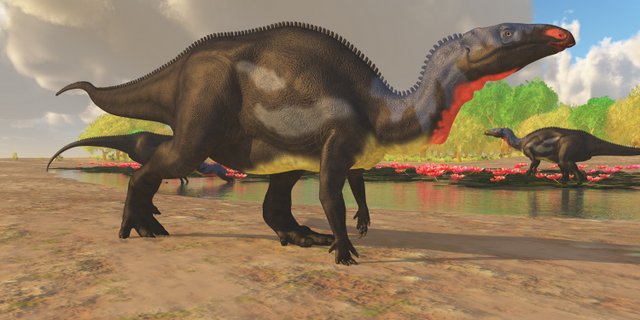
The two-legged dinosaurs walked in a somewhat upright stance on two legs, although some dinosaurs like Iguanodon, were thought to walk more horizontally and use their arms to counterbalance their weight.
The four-legged dinosaurs, such as the Sauropods, were the largest. Along with a huge body, they also had a long neck and tail.
There is also a Theropod that resembled birds, a group of dinosaurs called ornithopods because they had a hip that looks like a bird’s hip. They were super-fast dinosaurs that can achieve the speed of 40 km/h when they feel any danger around them.
Types of Plant-Eating Dinosaurs
In Table 1, the different types of herbivore dinosaurs are listed. Column one indicates the type, column 2 gives the name of dinosaurs that belong to that type together with a short description, and finally, in column 3, we indicate whether these dinosaur types were two-legged or four-legged.
Table 1 - Types of Herbivore Dinosaurs
| Type of Herbivore Dinosaur | Dinosaur & Description | 4-Legged or 2-Legged Dinosaur? |
|---|---|---|
| Sauropods | Apatosaurus, Argentinosaurus, Brachiosaurus | 4-Legged |
| Therapods | Iguanodon, Hadrosaurus, Muttaburrasaurus | 2-Legged |
| Armored | Triceratops, Stegosaurus, Protoceratops | 4-Legged |
| Bird-Like Therapods | Orinthomimus | 2-Legged |
| Omnivores (plant & meat eaters) | Therizinosaurus | 2-Legged |
| Type of Herbivore Dinosaur | Dinosaur & Description | 4-Legged or 2-Legged Dinosaur? |
What Was the Biggest Plant Eating Dinosaur? The Giant Sauropods
The giant Sauropods were the largest plant-eating dinosaurs and also the largest dinosaurs ever to exist. Interestingly, there are many famous herbivore dinosaurs. Fossil remains of these dinosaurs immediately give the impression of how big these dinosaurs were. Sauropods lived in current-day North America, South America, China, Europe, the Middle-East, and Africa – basically all over the world. The largest Sauropod was Argentinosaurus huinculensis, which was approximately 50-96.4 metric tonnes (55.1-106.3 short tons) and reached a length between 30-39.7 meters (98-130 feet). Source: Wikipedia
Long-Neck Sauropods
The giant Sauropods were not only big, but they also had extremely long necks. The first time I saw a Sauropod fossil was in London at the Natural History Museum. I later learned it was a plaster replica, but that didn’t take away from the experience of seeing it. The dinosaur was so huge, and the neck seemed to be half of the dinosaur. It was amazing and cool.
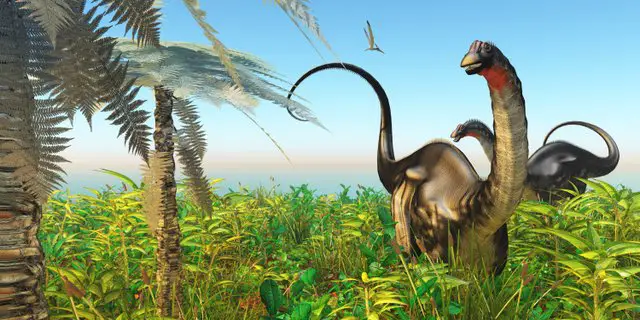
The advantage of a dinosaur having a long neck is that it can reach vegetation at the tops of trees, or to gather plants from side to side. Sauropods needed to eat lots of calories to sustain its big size, so the more plants it could reach, the better. The other advantage of a long neck is that it could also be used to nudge and knock predators.
What Is the Difference Between Sauropods and How Does the Brachiosaurus Differ?
Sauropods were a group of large herbivorous dinosaurs that roamed the Earth millions of years ago. While they may have appeared similar at first glance, there were distinct differences among sauropods, and the Brachiosaurus stood out in particular.
One significant difference among sauropods is their size. The Apatosaurus, for example, grew up to 69 feet (21m) long, making it one of the largest members of this family. Its name, meaning “deceptive lizard,” arose from its bones being mistaken for those of the mosasaur, a massive prehistoric aquatic animal.
Another difference can be seen in the structure of their bodies. The Brachiosaurus, often likened to a giraffe, had longer front legs compared to other sauropods. This unique feature, as reported by Live Science, caused its back to incline and its neck to point upwards, resulting in its distinctive giraffe-like posture.
In addition to these variations, other sauropods had their distinguishing characteristics as well. Each species within this group had specific anatomical traits that set them apart, such as variations in body shape, neck length, and bone structure. These differences contributed to the diverse range of sauropod species and allowed them to adapt to different environments and feeding habits.
Understanding the distinctions among sauropods, including the specific differences exhibited by the Brachiosaurus, helps paleontologists piece together the fascinating story of these extraordinary creatures that once inhabited our world.
The teeth of a Sauropod like Apatosaurus or Brachiosaurus was flat or cone-shaped, as mentioned earlier, designed to grind vegetation. A Sauropod could replace its teeth reasonably quickly too.
Paleontologists suggest, based on patterns of footprints, tail prints as well as fossil excavations that some species of Sauropods moved in herds, sometimes separating into different age groups. As they were all plant-eaters, it made sense to stick together to fend off predators. Additionally, they would travel far distances to get to greener vegetation.
Interestingly, some Sauropod dinosaurs like the Ampelosaurus is suggested to have had thick skin and spikes on its back, due to some of the indications the fossil remains had which have been found in Europe.
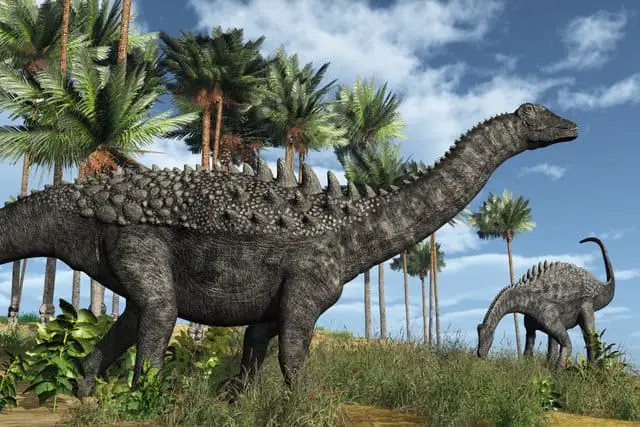
If you’re interested to learn more about long neck Sauropods, I wrote a whole article just about these incredible dinosaurs – check it out! – What Are Long Neck Dinosaurs?
List of Sauropods
In Table 2 below, the Sauropod dinosaurs are listed in column one, and a short description of the dinosaur is given in column 2. In the third column, it states where fossils of this dinosaur were found in the world.
Table 2 - List of Herbivore Sauropods
| Sauropod Dinosaur | Description of Dinosaur | Where Fossils of This Dinosaur Found |
|---|---|---|
| Argentinasaurus | South America | |
| Apatosaurus | North America | |
| Brontosaurus | North America | |
| Brachiosaurus | North America | |
| Mamenchisaurus | China | |
| Saltasaurus | 2-Legged | |
| Dreadnoughtus | 2-Legged | |
| Patagotitan | South America | |
| Sauropod Dinosaur | Description of Dinosaur | Where Fossils of This Dinosaur Found |
Were There Dangerous Herbivore Dinosaurs? The Armored Herbivore Dinosaurs
Many people think of plant-eating dinosaurs as being calm, a bit slow, and even docile – quite the opposite of a dangerous dinosaur. However, the fact is that some herbivore dinosaurs were dangerous, especially if attacked. They had evolved different adaptations to survive against aggressive threats of carnivorous dinosaurs. For instance, strong armor plates and skin, long horns, spikes, and clubs on the body and tail, were used to whip against predators. Let’s find out more about these armored, dangerous dinosaurs.
————————————————————————————————
Related Dinosaur Articles You Might Also Be Interested In:
Would A T-Rex Really Shake The Ground?
What’s the Difference Between Dinosaurs and Dragons?
How Would A T-Rex Get Up After Falling?
————————————————————————————————
General Description of Armored Dinosaurs
The armored herbivore dinosaurs were mostly four-legged, although some horns and armor or spikes were found on a few two-legged dinosaurs like Pachycephalosaurus. The teeth of these plant-eaters were similar to other dinosaurs in that they were shaped flat or coned so that they could grind vegetation.
One differentiator from carnivore dinosaurs is that instead of claws, four-legged armored dinosaurs had blunt hooves or toenails.
There isn’t full agreement among paleontologists on whether armored dinosaurs lived together in herds. Among the fossil finds of armored dinosaurs, they were found one by one, and not grouped together. If we take a look at modern-day mammals, for instance, rhinos, we see that most species live individually. However, the white rhino lives in herds with other female rhinos.
The time period that armored dinosaurs lived was from the late-Jurassic (Stegosaurs) to the late-Cretaceous (Ankylosaurs). Many of the fossil found in recent years have been armored dinosaurs from the late-Cretaceous.
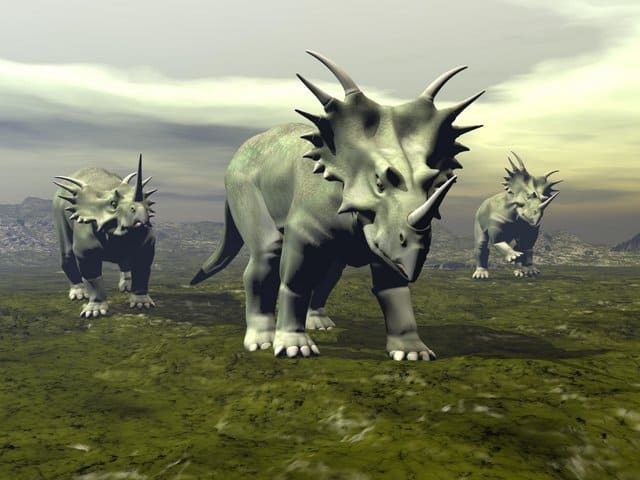
Stegosaurus and Its Spiked Tail
A stegosaurus is a large, herbivorous dinosaur that lived during the late Jurassic Period, around 150 million years ago. It is easily recognizable due to its unique physical features: a small head, a bulky body, a spiked tail, and two rows of large, bony plates along its back. These plates, which could reach up to 2 feet in height, served as a defensive mechanism against predators. Stegosaurus measured up to 9 meters in length and weighed around 5 tons. Despite its enormous size, it had a remarkably small brain, approximately the size of a walnut.
Stegosaurus, unlike scientists originally believed, had plates standing vertically along the length of its back. These plates were not laid on top of the dinosaur’s body, as previously thought. However, the exact purpose of these plates has been a subject of debate among researchers. Prof. Paul Barrett, a respected researcher at the Natural History Museum, suggests that these plant-eating dinosaurs may have used their back plates for display.
This could mean that the plates were used to attract mates, establish territory, or communicate with other members of their species. Such display behavior is commonly observed in various animals, and it is plausible that Stegosaurus utilized their unique back plates for similar purposes. Alternatively, there is another school of thought within the scientific community, as discussed by paleontologist Darren Naish. While some scientists consider thermoregulation, or controlling body temperature, as a possible function of the back plates, Naish suggests that the prevailing view is that Stegosaurus primarily used their plates for display.
This widely accepted notion emphasizes the significance of the plates in communication and social interactions among these dinosaurs. By understanding the diversity of opinions, we gain a more comprehensive perspective on the purpose of Stegosaurus’ back plates.
List of Armed Herbivore Dinosaurs and Descriptions
Here’s a list of armed herbivores. In the table below, the first column indicated the type of armor. In the second column, I state the dinosaur and a short description or interesting fact about the dinosaur. And in the third column, I indicate what the armor or weapon was used for either protection or fighting.
Table 3 - List of Armored Herbivores
| Type of Armor or Weapon on Dinosaur | Description of Dinosaur | How Armor / Weapons Used |
|---|---|---|
| Horns on Head | Triceratops | Fighting |
| Horns on Frill | Styracosaurus | Protection |
| Horns on Nose | Protoceratops | Fighting |
| Plates Along Back | Stegosaurus – Had plates along the back standing vertically. Colorado, USA is “the Stegosaurus State” , in tribute to the first Stegosaurus fossil found | Protection |
| Thick Armor Skin/Scales | Ankylosaurs and Nodosaurs | Protection |
| Spikes Body | Reference dinosaur – Iguanodon (thumb) and Nodosaurus | Protection |
| Spikes Tail | Stegosaurus | Fighting |
| Club Tail | Ankylosaurus | Fighting |
| Type of Armor or Weapon on Dinosaur | Description of Dinosaur | How Armor / Weapons Used |
What Is the Significance of The Scutellosaurus in Understanding the Evolution of Armored Dinosaurs?
The Scutellosaurus, despite its small size of approximately 3.9 feet, holds immense significance in our understanding of the evolution of armored dinosaurs. As one of the earliest ancestors of the Thyreopora, the discovery of this herbivorous dinosaur plays a pivotal role in shedding light on the evolutionary patterns of armored dinosaurs during the Mesozoic Era.
By studying the Scutellosaurus, paleontologists have been able to discern crucial insights into the development and diversification of armored dinosaurs. Its presence in the fossil record offers valuable evidence for tracing the evolutionary trajectory of this particular group of dinosaurs, providing a key missing link in our understanding. The Scutellosaurus showcases the gradual transition from non-armored dinosaurs to the well-known armored forms that later emerged. Its unique combination of characteristics, such as a relatively lower level of armor compared to later armored dinosaurs, gives important clues about the intermediate stages of this evolutionary process.
Furthermore, the Scutellosaurus allows us to investigate the morphological adaptations associated with the evolution of armor. The study of its anatomy provides valuable information on the development of protective structures, such as bony plates and spikes, that characterize later armored dinosaurs. This dinosaur serves as a bridge between the more primitive forms and the more advanced armored species, offering a clear understanding of the incremental changes that occurred over time. So, the significance of the Scutellosaurus lies in its role as an early ancestor in the Thyreopora group, providing essential information about the evolution of armored dinosaurs.
Its discovery and subsequent analysis have greatly contributed to our understanding of how these unique creatures developed and diversified during the Mesozoic Era. By studying the Scutellosaurus, paleontologists have obtained invaluable insights into the gradual transition and morphological adaptations that led to the emergence of the armored dinosaur forms we are familiar with today.
Types of Armor – Horns, Spikes, Plates, Clubs
Herbivore dinosaurs developed several different types of armor and weapons. Here are the main types:
Horns on the Head -These dinosaurs grew horns protruding out of the frill (a kind of shield that covers their neck). The Triceratops had three horns. Another dinosaur, the Styracosaurus, had horns on the frill shield.
Plates on the Body –These dinosaurs had plates standing vertically along the length of the back of the dinosaur. Interestingly, scientists first thought these plates were laid on top of the dinosaur’s body, but later realized they stood vertically.
Spikes on the Body –The Nodosaurus had large spikes along both sides of its body and also its head. The Iguanodon had a spiked thumb. This spiked thumb was used for protection and also for cutting through vegetation.
Spikes on the Tail – The most well-known dinosaur that had spikes on their tail was the Stegosaurus, which used the spikes on the tail to deliver a blow to possible predators like Allosaurus.
Clubs on the Tail – The Ankylosaurus had a bone-formed club at the end of its tail, and this tail was used similar to the Stegosaurus, swinging the tail to deliver a blow against a predator.
Armored Dinosaurs and How Their Armor Covered Their Bodies
Armored herbivore dinosaurs, known as Thyreophora, possessed a variety of unique characteristics and defensive mechanisms. These mighty creatures were heavily built and boasted clubbed tails, ensuring that they were not to be underestimated. Their bodies were adorned with an array of impressive armor, serving as a formidable defense against potential predators and providing protection from the elements.
Among the types of armor developed by these herbivores, horns on the head stood out as prominent features. Dinosaurs such as the Triceratops sported three horns, while others like the Styracosaurus displayed horns on their frill shield, a protective structure covering their neck.
The armor of these dinosaurs extended beyond mere head adornments. Vertical plates adorned the length of their backs, creating an intimidating appearance. These plates were initially believed to lie flat on the dinosaur’s body, but further study revealed that they actually stood upright, enhancing their defensive capabilities.
Not to be outdone, some herbivorous dinosaurs developed spikes along their bodies. The Nodosaurus boasted large spikes running along its sides and head, while the Iguanodon possessed a particularly unique feature – a spiked thumb. This specialized adaptation served both as a means of self-defense and as a tool for cutting through vegetation, emphasizing their herbivorous nature.
The tail of armored herbivores held its own defense mechanisms. The Stegosaurus, renowned for its iconic appearance, boasted spikes on its tail, which it skillfully utilized to deliver powerful blows to potential predators such as the Allosaurus. Meanwhile, the Ankylosaurus possessed a bone-formed club at the end of its tail, further enhancing its defensive capabilities. By swinging its tail, this dinosaur could deliver a formidable blow against any would-be assailant.
An intriguing discovery pertains to a particular species of dinosaur that underwent a dramatic dietary shift. Scientists suspect that the Therizinosaurs, originally carnivorous, transitioned into plant-eaters. These aggressive creatures possessed long arms with deadly claws, featuring spikes that added to their formidable arsenal. Despite their fearsome appearance and armor, they are now considered to be herbivorous dinosaurs, further challenging our understanding of these magnificent creatures.
In summary, armored herbivore dinosaurs possessed a range of distinctive characteristics, including horns, plates, spikes, and clubs. These features served various purposes, from defense against predators to cutting through vegetation. Their remarkable adaptations highlight the diverse ways in which these dinosaurs thrived and adapted to their environment, leaving a lasting impact on the world of paleontology.
What Makes the Hesperosaurus Significant as The Oldest Known Stegosaurus in America?
The Hesperosaurus holds great significance as the oldest known stegosaurus in America due to its ancient origins and the rarity of its existence. With a skeleton dating back approximately 156 million years, this herbivorous dinosaur stands as a testament to a bygone era in American history.
Being the oldest stegosaurus found in the country, the Hesperosaurus provides invaluable insights into the evolution and diversity of dinosaurs in America during the Mesozoic era. Its existence allows paleontologists and researchers to unravel the mysteries surrounding the early evolution and behavior of stegosaurs, shedding light on the ancient ecosystems and the interplay between different species that once flourished on American soil.
Through the discovery and study of the Hesperosaurus, our understanding of the prehistoric world, particularly in relation to stegosaurs, is greatly enhanced, providing a window into the distant past and expanding our knowledge of the incredible diversity of life that once roamed the American continent.
One interesting note is the case that scientists suspect is a species of dinosaur that turned from being carnivores into vegetarians. That species was the Therizinosaurs. They were aggressive and had some long arms with long claws, and on top of that, the claws had deadly spikes. These dinosaurs, despite the armor, are considered to be plant-eating dinosaurs. If you are interested in dinosaur weapons and armor, I wrote this article How Did Dinosaurs Protect Themselves? (Armor, Weapons) that explains it in more detail.
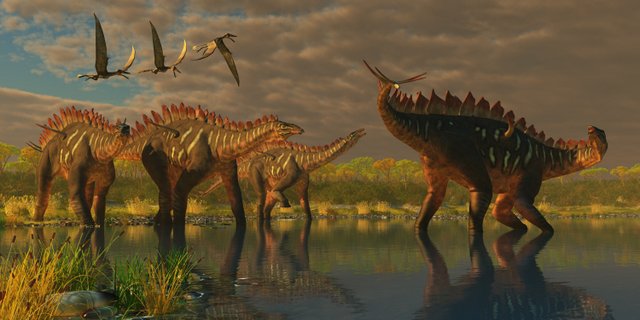
Why Are the Spikes on The Gargoyleosaurus Less Intimidating than Those on The Ankylosaurus?
The Gargoylesaurus, a creature from the Late Jurassic period, played a vital role in the evolutionary history of the Ankylosaurus. It served as the ancestor to this remarkable armored dinosaur, gradually developing the iconic body armor that would become more prominent in its successors.
The spikes on the Gargoylesaurus, as compared to those of the Ankylosaurus, may appear less intimidating. This can be attributed to the fact that, during the Late Jurassic period, the Gargoylesaurus was in the early stages of evolving its defensive features. The development of its armor was still in progress, and the spikes were not as fully formed or pronounced as those of its more derived descendant. While the Gargoylesaurus did possess some spikes on its body, they were likely smaller and less pronounced compared to the later species.
These spikes may have served a more subtle role, potentially as a means of deterring predators or as a primitive form of protection. However, they were not as extensively developed as the robust and intimidating spikes seen on the Ankylosaurus. Moreover, as evolution progressed, the Ankylosaurus underwent significant modifications, resulting in the development of larger, more formidable spikes. These spikes, which were highly adapted for combat and defense, would have been considerably more menacing and imposing than those of its ancestor, the Gargoylesaurus.
The spikes on the Gargoylesaurus were less intimidating than those of the Ankylosaurus due to its earlier evolutionary stage. As the Gargoylesaurus gradually developed its body armor, its spikes were not as fully formed or as prominent as the robust and formidable spikes that later adorned the Ankylosaurus.
How Does The Gastonia Threaten Opponents Without A Clubbed Tail?
Gastonia, a type of armored dinosaur, possesses a unique method of intimidating its adversaries without relying on a clubbed tail like some of its armored counterparts. Rather than an imposing tail weapon, Gastonia exhibits an array of extra-large, vertical spikes protruding from its shoulders. These prominent spikes serve as an effective means of threatening opponents during confrontations.
By virtue of their size and positioning on the dinosaur’s shoulders, these spikes create an intimidating visual display. When faced with an adversary, Gastonia would lower its head, elevate its erect spikes, and adopt a defensive stance. This threatening posture would likely deter potential attackers, as the size and prominence of these spikes signal Gastonia’s readiness to defend itself.
Additionally, the Gastonia’s shoulder spikes could potentially be used offensively. In close combat situations, as hostile interactions escalate, the dinosaur could swiftly thrust its body forward, exploiting the spikes’ length and sharpness to inflict damage upon opponents. The spikes would act as formidable puncturing tools, capable of piercing an opponent’s flesh or acting as a deterrent. Gastonia’s ability to utilize its shoulder spikes in both a defensive and offensive manner showcases its adaptability and resourcefulness in the face of potential threats.
The Gastonia effectively intimidates adversaries without relying on a clubbed tail like some other armored dinosaurs. The dinosaur’s large, vertical spikes positioned on its shoulders create a visually imposing display during confrontations, signaling its readiness to defend itself. Furthermore, the Gastonia may employ these spikes offensively, using them to puncture and deter opponents in close combat situations.
Parting Shot
When one first starts learning about dinosaurs, it’s common that the carnivore dinosaurs like the T-Rex or Velociraptors are often the first noticed and learned about. Probably it’s because of the popularity of the dinosaur or the one most seen in the movies. However, as we have discussed in this article, the herbivore dinosaurs had some cool features and traits that set them apart from predators, and they can be just as amazing and dangerous as meat-eating dinosaurs. I’ll always be amazed at how cool the giant, long-necked herbivore dinosaurs are!
Frequently Asked Questions
What Is Unique About Udanoceratops’s Appearance?
The Udanoceratops stands out for its distinct appearance as a horned dinosaur. What makes it particularly unique is the absence of horns above its eyes or nose, which is a characteristic commonly seen in other horned dinosaurs. Instead, it possesses a short frill in that area, giving it a different look. Additionally, the Udanoceratops has small horns located on the sides of its head, further contributing to its intriguing and unconventional appearance.
Is Nedoceratops a Distinct Species or A Growth Stage of Triceratops?
In order to determine whether Nedoceratops is a distinct species or a growth stage of Triceratops, the passage provides differing viewpoints from notable scientists. Initially, both John Scanella and Jack Horner, who have extensively studied the Nedoceratops fossil, believed that it was a Triceratops transitioning into a Torosaurus. However, the expert on Ceratopsians, Andrew Farke, disagrees with this interpretation. Farke argues that Nedoceratops is indeed a distinct species. Currently, the passage suggests that it remains uncertain whether Nedoceratops should be classified as a separate species or simply a growth stage of Triceratops, thus indicating the need for further investigation and evidence.
How Long Did the Anchiceratops Species Survive?
The Anchiceratops, a herbivorous dinosaur, managed to survive for an impressive duration of approximately 2,000,000 years. This remarkable endurance distinguishes it from its predecessors, as older species of horned dinosaurs typically persisted for only around 700,000 years, as reported by the Smithsonian Magazine.
Did the Tsagantegia Use Browsing or Grazing as A Feeding Strategy?
According to recent research, the Tsagantegia, an armored herbivore dinosaur, employed browsing as its primary feeding strategy. This conclusion was made based on the unique shape of its rostrum, which resembled a shovel. Browsing is a feeding behavior characterized by the consumption of non-grass and taller plants such as shrubs and leaves. In contrast, grazing involves the consumption of grass or plants found at ground level. Therefore, it can be deduced that the Tsagantegia predominantly utilized browsing rather than grazing in its feeding habits.
Was Thermoregulation a Possible Purpose for The Plates on The Stegosaurus’s Back?
According to paleontologist Darren Naish in his article published in Scientific American, there is a divergence in opinions within the scientific community regarding the possible purposes of the plates on the Stegosaurus’s back. While some members believe that thermoregulation could have been a potential function, Naish suggests that the more plausible and widely accepted explanation is that the Stegosaurus utilized its distinctive back plates for display.
How Do the Spines of The Sauropelta Differ from Those of Gastonia?
The Sauropelta, a type of armored herbivore dinosaur, features an intriguing distinction in its spines compared to the Gastonia. While both species have prominent spines protruding from their bodies, the location of these spines sets them apart. Unlike the Gastonia’s spines that originate from their shoulders, the spines of the Sauropelta arise from their necks. This disparity in the placement of these formidable structures showcases a unique aspect of their anatomical designs.
What Recent Discovery Shed Light on The Nodosaurus and What Information Does It Provide?
A recent discovery in 2017 has provided valuable insight into the Nodosaurus, an herbivorous dinosaur closely related to Ankylosaurs. This remarkable find consists of an incredibly well-preserved fossil that goes beyond just bones. In addition to skeletal remains, it includes the remnants of skin, armor, and possible traces of food. This discovery has opened up new avenues for research and promises to greatly enhance our understanding of the Nodosaurus. As scientists continue to study the fossil, they will uncover valuable information about the physical characteristics, behavior, and dietary preferences of this ancient creature.
Why Is the Discovery of The Gobisaurus Important in Understanding the Evolution of The Ankylosauridae Family?
The discovery of the Gobisaurus is of significant importance in comprehending the evolution of the Ankylosauridae family. By investigating and analyzing this herbivorous dinosaur, which was unearthed during the Sino-Soviet Expeditions between 1959 and 1960, scientists have gained valuable insights into the evolutionary journey of the Ankylosauridae lineage from its earliest ancestral form to its most recent known member. This crucial finding has allowed researchers to fill in vital gaps in our understanding of the evolutionary progression and development of this particular family of dinosaurs.
How Big Is the Omeisaurus Compared to Other Dinosaurs?
The Omeisaurus is considered one of the smaller dinosaurs in terms of size compared to its counterparts. Measuring only about 35 feet in length, it falls on the shorter end of the spectrum when it comes to herbivorous dinosaurs. In contrast, there are much larger sauropods like the Apatosaurus, which could grow up to 69 feet in length, and the Giraffatitan, which could reach an impressive length of about 80 feet. While the Omeisaurus may not be as gigantic as these other sauropods, it still played a significant role in prehistoric ecosystems as a smaller leaf-eating dinosaur.
What Makes the Mamenchisaurus Standout Among Other Dinosaurs?
The Mamenchisaurus is a remarkable dinosaur that stands out among others for its extraordinary features. One of the most striking characteristics of this herbivore is its incredibly long neck, measuring 30 feet in length. This makes the Mamenchisaurus hold the record for having the longest neck in proportion to its body among all dinosaurs, as noted by the AMNH (American Museum of Natural History). This exceptional trait sets it apart from its prehistoric counterparts, making it a truly unique and awe-inspiring creature.
What Is the Size of The Alamosaurus and Its Significance in North America?
The Alamosaurus, an enormous dinosaur from Texas, holds the title of the largest dinosaur in North America. This herbivorous creature boasted an impressive size, with an astounding height of 98 feet. Its sheer magnitude allowed it to cover vast distances, making it a highly formidable presence in the region. The Alamosaurus’s towering stature and immense length make it a species of great significance and intrigue in the realm of North American dinosaurs.
What Exactly Is a Herbivorous Dinosaur?
A herbivorous dinosaur, or herbivore, is an animal that gets its energy from consuming plant materials. They developed specialized adaptations, such as beaks and flat teeth, that were perfect for stripping and grinding plant materials, to aid in their plant-focused diet.
Can You Identify Some Famous Herbivorous Dinosaurs?
Some of the famous herbivorous dinosaurs include the diplodocus, triceratops, stegosaurus, and Brachiosaurus among others. Individually, these dinosaurs were some of the largest herbivores that ever lived on Earth.
When We Think of Dinosaurs, We Often Think of Ferocious Creatures. Were All Dinosaurs Ferocious?
No, not all dinosaurs were ferocious hunters. Many dinosaurs were herbivores, which means they ate only plants and ferns. They lived millions of years ago and had a more passive existence compared to their carnivorous counterparts.
Which Dinosaur Is Considered to Be the Largest Herbivore?
The largest herbivore dinosaur is generally recognized to be the Argentinosaurus. It was approximately 30-40 meters (98-131 feet) long and is one of the largest land animals that ever existed.
What Did the Herbivorous Diplodocus Dinosaur Eat and How?
Diplodocus, one of the most famous herbivorous dinosaurs, primarily ate plants and ferns. It had flat teeth and a long neck allowing it to reach the leaves and branches of trees. The flat teeth were ideal for stripping and grinding plant materials.
Did All Dinosaurs Eat Plants?
No, not all dinosaurs ate plants. While a large number of dinosaurs were herbivorous and had a diet consisting mainly of plant materials, there were also many carnivorous dinosaurs that hunted and consumed other dinosaurs and animals.
Can You Provide More Information About the First Dinosaurs and If They Were Herbivores?
The first dinosaurs that lived over 230 million years ago were small and walked on two legs. Most of these early dinosaurs were carnivores. However, plant eaters appeared soon after, showcasing the diverse dietary habits of dinosaurs.
How Did Herbivorous Dinosaurs Manage to Digest Hard Plant Materials?
Herbivorous dinosaurs had a highly efficient digestive tract that could break down tough plant materials. Some had gizzards filled with small stones which helped them grind up tough vegetation. Many also had lengthy fermentation periods to break down the cellulose which was a large part of their diet.
Are There Any Specific Adaptations that Herbivorous Dinosaurs Had?
Herbivorous dinosaurs had several specific adaptations to aid their plant-based diet. They had strong, flat teeth for grinding plant materials, long necks for reaching tree foliage, and large stomachs for accommodating the volume of plant material required for sustaining their large bodies.
Did Any Herbivorous Dinosaurs Exhibit Defensive Capabilities Against Predators?
Yes, despite being plant eaters, many herbivorous dinosaurs had impressive defensive capabilities. For instance, the Triceratops had large, sharp horns and a solid frill for protection. Stegosaurus had keen spikes on its tail for self-defense. These and similar adaptations made herbivorous dinosaurs far from the harmless creatures they’re often thought to be.
